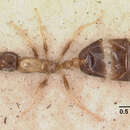The bicolored trailing ant, or flower ant, (
Monomorium floricola), is a minute light brown ant with an elongated body, distinctly bi-colored with a black head and abdomen. It probably originated in the tropical Asia, but through human commerce is now established throughout the tropics and sub-tropics world wide, nesting in bushes and trees. It also commonly inhabits homes in urban areas, even in temperate climates and as far north as Alaska. This arboreal species eats insect eggs as well as insects, living or dead, tends aphids, mealybugs and other honeydew-producing insects, and visits extra-floral nectaries and flowers for nectar. Like its sibling species, the Pharoah ant (
M. pharoanis), its nests contain multiple queens, and it forms new colonies by budding of its population. A slow moving and cryptic ant, it is usually considered a minor pest despite its world-wide abundance, and appears to be able to co-exist with other ant species, perhaps due to its small size. It may have more of an impact on ecosystems than is currently assessed, because its presence is often overlooked. (
Ferster, Deyrup, and Scheffrahn;
IUCN/SSC Invasive Species Specialist Group 2010;
Wetterer 2010)

